Everything you need to know about project management terms is here in one list! Plus we’ve added handy links to help you dive deeper into different topics with videos, articles and even our round-up of all resources so you can put these important terms into practice with your projects.
Check back often, as this list of project management terminology is ever-evolving, just like project management itself!
Find a term you want defined that isn’t on this project management glossary? Contact the editors via Twitter @ProjectTips with hashtag #PMGlossary and let us know!
100+ Project Management Terms in Alphabetical Order
Here’s our complete list of over 100 project management terms organized in alphabetical order.

A – Project Management Terms
Acceptance criteria
The metric by which a project will be measured to determine whether it’s successful or not. These are predefined requirements that must be met by the project for it to be considered done, whether that’s a task, user story or the whole project.
Agile
A methodology for project and product management is typically used to deliver software projects iteratively with short bursts of work called “sprints.” Though initially designed as a process for IT and engineering projects, it has since been successfully applied to other industries like marketing. As the methodology has gained in popularity, agile (with a small “a”) has become a general business approach to support a more flexible working style with quick turn-around.
Arrow Diagramming Method
A network diagramming technique that represents the start and end of activities with arrows to help with scheduling in the project planning phase. The longer the duration of the project, the longer the length of the arrow.
Devin Deen explains how to use Activity on the Arrow diagramming to chart the critical path in this video.

B – Project Management Terms
Backlog
Backlog is a term from the Agile methodology Scrum, but is also used across industries to track every single thing that is needed to complete a product in development. It is also used to capture requests for modifying the product and ensuring delivery with scope.
Baseline
A baseline is an estimate of the project’s scope, schedule and costs that is created during the planning stage. Its main purpose is to serve as a reference that is compared to the project performance once the execution phase begins. The baseline is established based on different sources of information such as project files from previous projects or subject matter expert opinions.
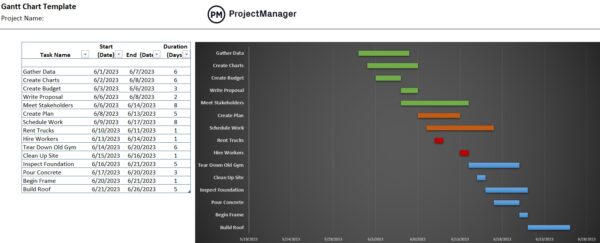
Business case
A business case is either a written or verbal proposition used to educate and sway the decision-makers in an organization to take on a project because it is going to deliver a return on investment or provide some worthwhile benefit.
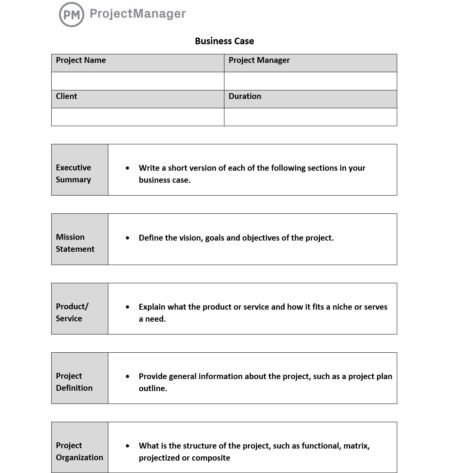
Business plan
A formal document that clearly defines the business goals of a project and how to attain them. It is also called a Business Case. It includes the plans to fulfill these goals. There may also be some background information about the organization or team tasked to reach this goal.

C – Project Management Terms
Capability Maturity Model (CMM)
Developed from a US Department of Defense study, the model is used to develop and refine software processes. It helps to model the maturity of the capability of business process by defining steps and managing result metrics to optimize the process.
Change control
The term for a process to systemically monitor and approve or reject any change requests made to a product or project. The process is designed to increase project efficiency and minimize scope creep by controlling every change and ensuring that changes are made according to set requirements for approving change.

Change management
The method for managing project change requests and application of the change control process as defined above. The goal with change management is to avoid scope creep in a project and produce maximum efficiency during the project.
Change Management Plan
Process to implement and manage change in a project. Will determine if a requested change is worth pursuing or not depending on factors such as cost, time and other impacts to the project. It also is used to respond to changes that occur in the project whether due to the environment, equipment or other factors.
Case study
Used for a variety of purposes, case studies are generally research-based papers that deeply examines use cases of products in given applications or how different industries applied specific practices or approaches to their projects.
Certified Associate in Project Management (CAPM)
An entry-level certification offered by the Project Management Institute.
Communications log
A record of continuous documentation of communications between project stakeholders managed by the project manager. Project managers make logs to manage change requests or to document public sector projects for future audit or oversight committees in more formal project environments. In more informal organizations, communications logs can be chats, discussions and email threads, and in fact, some project management software adds email conversations related to the project directly on the task or project level, to keep project documentation organized.
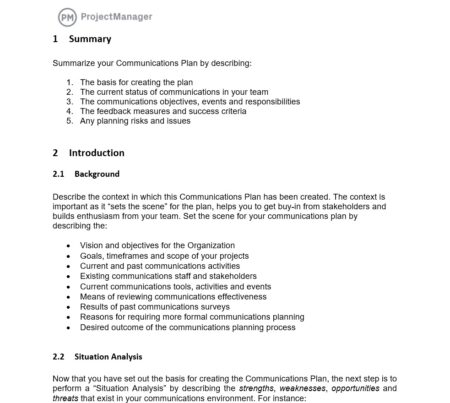
Collaboration
Working with one or more parties on the same project and similar goals. It’s the act of delegating and communicating between team members and distinct teams to better serve the product by providing more minds and hands. More than that, though, collaboration is a way of working with new tools like social platforms, real-time document sharing and editing, and remote working. For some companies, collaboration is perceived to be a “culture” promoted within the business to support Agile or iterative ways of running projects or simply to support knowledge sharing within the org.
Contingency
A plan for possible disasters occurring during your project, whether that be of man-made or natural variety. It’s not merely data backup but includes that and every other detail to ensure the project isn’t derailed by considering short- and long-term events and how to respond to them.
Cost Benefit Analysis
How to calculate the potential benefits of a project in terms of money and then subtract the cost of the project from this figure. A cost benefit analysis will then determine if the project is worth the investment and whether it should be initiated or passed on.
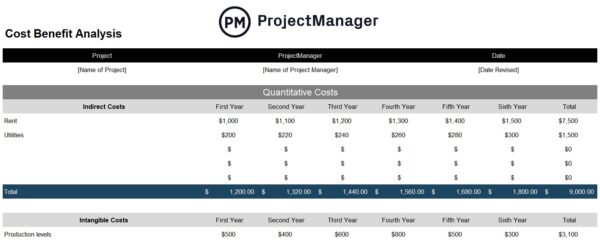
Cost overrun
This is the actual cost that exceeds the estimated cost in the budget, also known as a cost increase or budget overrun. It usually is unexpected and unwanted as it requires finding new resources to cover these unseen expenses.
Critical path method (CPM)
An algorithm for scheduling a set of project activities, typically the “critical path” or shortest path through a project. It was developed in the late 1950s within the DuPont organization and Remington Rand company as a method to know mission-critical tasks. Modern project management software applications can streamline finding your project’s critical path to help you manage scope and monitor the project.

D – Project Management Terms
DACI
Used to define roles and responsibilities in the project. This acronym stands for driver, the individual who drives decisions, approvers, who make the decision, contributors, who work on the project or provide knowledgeable guidance, and informed, whose work is likely to be affected by the decision.
Dashboard
A graphical way to share essential project data with stakeholders, a dashboard that makes diverse amounts of data and its underlying information easily digestible. Traditionally, dashboards were created “manually” by assembling select pie charts or data graphs in a presentation view. The data, however, was often outdated by the time of the presentation. Modern project management tools offer real-time dashboards, so the data is viewed usually by bringing a laptop or tablet to a presentation or through client logins to the software so everyone has access to the freshest data.
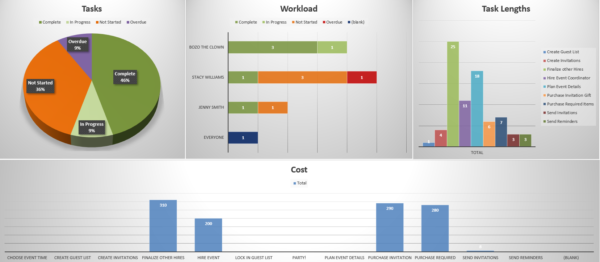
Dependency
Tasks or other activities that are interdependent on a project. Often one activity cannot take place before another one being completed. In this way, they are linked in a project and can be noted as such in online project management tools. When you add a dependency in online project management software, you create a dependent-virtual link between two tasks to demonstrate that constraint.
Deliverable
Something contracted for delivery. It is a tangible item or intangible objective, but crucial to the success of the project. It can be a report, a document, some project building block or the end product delivered at the end of a project.

E – Project Management Terms
Earned value management (EVM)
A way to measure project performance, and is commonly used in government projects. Here’s how EVM can be applied over the course of a project’s duration.
Estimation
In a project context, estimation is the way to make accurate budgets or timelines for a project. There are various techniques in estimating to help you get the most accurate predictions of cost and time.
Read our post on getting your team to help you get the best estimates.
Event chain diagram
This is a visual way of demonstrating the relationship between events and tasks and how they impact one another.
Event chain methodology
A method that focuses on identifying and managing events and series of events that impact a project’s schedule.

F – Project Management Terms
Fast-tracking
This refers to a technique project managers use to speed up their projects. Typically, schedules are analyzed to identify areas where some tasks can be done in parallel versus sequentially, or where new resources can be added mid-way through a project, adjusting the project plan.
Related: How to Fast-Track Your Project
Feasibility study
A feasibility study is a way to ascertain whether the proposed plan or methodology prescribed is practical in terms of fulfilling the goals of a project. For large projects, these can be detailed research studies. For smaller projects, they can be more informal assessments using existing business documentation like market research and informal internal polls with key stakeholders.
Float
This refers to time that a task can be delayed without blocking other tasks, or in layman’s terms: “wiggle room.”

G – Project Management Terms
Henry Gantt
American mechanical engineer and management consultant who developed the Gantt chart in 1910.
Gantt chart
The horizontal bar chart that illustrates a project’s schedule from start to finish by demonstrating the task duration visually. It’s named after Henry Gantt, who developed it in 1910 (though Karol Adamiecki did so, too, independently in 1896). Gantt charts are traditionally used in Waterfall project planning, for long-term projects that have many task dependencies. They are the backbone of formal project management software applications, most of which are now fully online and can be used interactively and collaboratively.
Learn more in our Ultimate Guide to Gantt Charts.

H – Project Management Terms
Hybrid methodology
Refers to the use of two or more separate methodologies on a project, commonly a blend of Agile and Waterfall project management methods, though sometimes incorporating kanban, lean or other methodologies of project management. Employing hybrid methodology enables teams to apply what works best where and when it is most needed, or to suit different teams within an organization.
Learn more about how teams can use hybrid methodology in this piece by contributor Mario Henrique Trentim.

I – Project Management Terms
Initiation
This refers to the first phase in the lifecycle of a project, according to traditional project management practices. It’s the stage in the process where the project is first conceived and scoped. It also involves the hiring of a team, setting up a project office and reviewing the project, as well as gaining approval for the project.
Iterative and incremental development
This is a method of project development, usually applied in software and IT projects, that evolved in response to weaknesses in the waterfall model to support rapid deployment. It is commonly employed in Agile and Lean projects, often in response to end-user feedback in product development cycles.

K – Project Management Terms
Kanban
This term literally means signboard or billboard in Japanese and was developed in Japan by Taiichi Ohno, an industrial engineer at Toyota, as a scheduling system for lean and just-in-time production. Kanban project management controls the logistical chain from a production point of view, formally, but has since been used more popularly as a visual way to track tasks for individuals or teams. This is usually executed with online kanban software.
Learn how Kanban and Scrum differ in the blog Kanban vs. Scrum: Which is Better?
Key Performance Indicators (KPIs)
A quantifiable measurement that is used to evaluate a project and determine if it is performing as planned. KPIs can be anything from cost to time, scope or quality.
Kickoff meeting
This refers to the first meeting to formally start a project and usually involves key stakeholders, team members and clients, depending on the nature of the project. There are best practices defined for how to run this type of meeting, which usually includes communicating the overall project vision, plan, processes and expectations.
Watch Jennifer Bridges in this video on Your Project Kickoff Checklist or check out The Only Project Kickoff Checklist You’ll Ever Need.

L – Project Management Terms
Level of effort (LOE)
A support-type project activity that must be done in order to support other tasks or even the entire project. The level of effort is often work that is periodically repeated throughout the lifecycle of the project.
Lean startup
This method (or movement) for developing businesses and products was first proposed in 2011 by Eric Ries and is based on his experience working on various startups. It says that startups can shorten their product development cycles by adopting a combination of business-hypothesis-driven experimentation, iterative project releases and validated learning
Lean manufacturing
A theory of expenditure of resources for any means other than the creation of value for the customer is considered wasteful and should be deleted.

M – Project Management Terms
Management process
The planning and controlling of a performance of an activity.
Management science (MS)
A discipline that uses mathematical modeling and other analytics to make better business management decisions.
Megaproject
A very large-scale work, often spanning multiple years.
Milestone
This is a way to mark a specific point along the lifecycle of a project’s timeline to bookmark upcoming major accomplishments, including the start, finish, external review, budget checks, etc. They are points along the project that must be reached according to schedule for the successful completion of the project.
Learn more about how to use milestones in project scheduling.
Minimally Viable Product (MVP)
This is a term that refers to releasing a product with the highest return on investment versus risk, and was coined as a term by Frank Robinson and popularized by Steve Blank and Eric Ries. It often refers to the product or project scope pre-launch to avoid unnecessary scope creep; that is, teams can get stuck trying to build new features into products in an attempt to please stakeholders or end users, rather than releasing the MVP and getting the product released quicker to the market.
Monitoring
This is a phase in the project management lifecycle, specifically the act of continuous awareness of the course of a project plan. Project monitoring involves checking whether a project is proceeding according to schedule and within the proposed budget, as well as checking into the health of your team. Monitoring can be accomplished through reporting, dashboards and active management with a team.
Learn tips on How to Monitor Projects.
MoSCoW method
A technique used to prioritize through the use of a four-step process. MoSCoW is an acronym for must-have, should have, could have and won’t have or not right now. By giving each task one of these distinctions, project managers can determine when or if they should be executed.

N – Project Management Terms
Network diagram
A flow chart or graph that shows the sequence in which a project’s terminal elements are to be completed by showing its terminal elements and their dependencies. It is drawn from left to right to reflect the chronology of a project.
Tip: Network diagrams can be an alternative to Gantt charts.
Nonlinear management (NLM)
A strategy permitting order to arise by giving organizations space to evolve and adapt, encompasses agile, evolutionary and lean methodologies.

O – Project Management Terms
Online project management software
A suite of online tools and features (versus downloadable software) used to plan, monitor and report on a project. It’s usually collaborative and has a dashboard in which the complex flow of information can be simply and easily digested.
Operations management
The area of a business responsible for efficient and effective production.
Operations research (OR)
Applying mathematics and science to developing methodologies to improve production.
Organization development (OD)
Planned systematic effort to raise the effectiveness of the organization.

P – Project Management Terms
Planning
The process of creating and maintaining a plan. In formal project management, this also refers to a phase in the Project Management Lifecycle.
Learn more in our Ultimate Guide to Project Planning.
PRINCE2
A formal project methodology that plans, monitors and controls every aspect of the project and motivates participants to achieve goals on time and within budget. PRINCE2 (PRojects In Controlled Environments – version 2) is typically used in the UK and Europe and also refers to a certification for project managers working on projects in those geographies.
Product breakdown structure (PBS)
Detailed, hierarchical tree structure of components that make up an item, arranged in relationship to a whole project.
Productivity
A way to measure the efficiency of a project in converting inputs into useful outputs, and is computed by dividing average output per a specific period by the total costs incurred or resources consumed in that period.
Program evaluation and review technique (PERT)
A PERT chart is a statistical tool that analyzes tasks in projects.
Program management
The process of managing a program, typically used in larger organizations with formal project management processes in place.
Project
An activity with a defined start and end date. This is versus ongoing operational work in organizations. Projects can be managed differently due to their temporary nature, even if they are multi-year in length.
Project charter
This is a statement of the scope, objectives and participants in a project, the document makes everyone involved in the project aware of its purpose and goals.
Use our free project charter template to save you time on your next project.
Project management
The name for a discipline that involves the planning, organizing, motivating and controlling of resources to achieve a specific goal. It is based on a temporary course of action, usually creating a product or service, and so is constrained by a deadline as well as a budget.
Project Management Body of Knowledge (PMBOK)
A standards of practice guide to professional expertise in project management profession, standardized by ISO.
Project management office (PMO)
PMO is the title for the person or business group within an organization that maintains the standards of the project process.
Project management lifecycle
Refers to the length of a project from conception to completion and all steps in between, according to distinct phases of delivery.
Learn more about the PM lifecycle in this book.
Project management professional
This can refer to a professional project manager working in any field and typically refers to those certified project managers, which can include Project Management Professional (PMP) and Certified Associate in Project Management (CAPM) to entry-level certification, such as CompTIA Project+.
Project management software
Software to facilitate project management that can be downloaded or wholly online.
Project manager
The term to describe any professional in charge of leading and managing a project.
Read our Ultimate Guide on Project Management.
PMP (Project management professional)
This refers to a valued certification in project management that rigorously tests knowledge and skill in managing all of the triple constraints: time, cost and scope. It is offered by the Project Management Institute.
Project network
A flow chart of the project schedule (see network diagram).
Project plan
A formal and approved document outlining the course of the project from start to finish.
Follow Stephanie Ray’s 12 steps when planning for a project.
Project Portfolio
A collection of projects or programs that are being managed together to get the most financial gain and meet the strategic goals of an organization. Unlike a program, which is a group of related projects, a portfolio can be diverse and unrelated but still must share resources and meet strategic goals.
Project team
Any group of people engaged in helping a project come to completion. This video by Jennifer Bridges, PMP, offers an outline of the roles for the project manager and their team.

Q – Project Management Terms
Quality assurance (QA)
The degree of excellence related to the project as well as a process to adhere to quality measures. Learn how to set quality targets in your plan by watching this short video by Jennifer Bridges, PMP.
Quality control (QC)
The procedure or set of procedures by which one ensures that a product or service is aligned to its defined goals and meets with the client’s or customer’s approval.
Quality, cost, delivery (QCD)
A lean methodology focusing on key performance indicators.

R – Project Management Terms
RACI
An acronym that stands for responsible, accountable, consulted and informed. RACI is used to chart the decision-makers of a project in order to manage their expectations and keep them informed of the progress of the project.
Reporting
A process of creating a document that gathers and delivers to the team, sponsor or client a snapshot of the results of the project at a specific time in its lifecycle.
Resources
Who or what is required to fulfill a project? This can refer to people or machines or a room rental, etc., that typically bills on an hourly basis.
Resource allocation
The act of assigning tasks to the available resources dedicated to a project, usually within a defined budget.
Resource leveling
A way to manage resource allocation to resolve possible conflicts arising from over-allocation.
Resource management
The process of managing teams and other resources on projects, and often includes managing their time, cost, performance and quality as it relates to defined project goals. Learn how resource planning software can help with resource management.
Risk
On projects, risk refers to the precise probability of specific issues and how they may impact the project.
Risk management
In a project context, this refers to a project method of reducing risk related to a project by actively identifying potential risks, plotting them in a risk register document or in your project management tool, and monitoring risks throughout the project. Learn more about risk management here.
Risk register
A way to organize and prioritize risks, either on a spreadsheet or through a project management tool, to assess potential impacts. Download a free Excel risk planning template here.

S – Project Management Terms
Schedule
Simply a collection of tasks defined by their start and end dates within a project plan. We’ve outlined tips for you to improve your schedule management.
Scientific management
A theory analyzing workflow processes to improve productivity.
Scope
This refers to the sum total of all tasks, requirements or features in a project. New requests or features or tasks added after a project has been planned are commonly referred to as “out of scope.” Project and product managers have to actively manage the scope of projects to make sure projects meet targeted goals and deadlines.
Scope creep
This refers to an uncontrolled change in a project’s scope. See our article about managing scope creep.
Scope statement
A document that defines a project. It’ll include assumptions, all project requirements and the criteria for accepting the project as successful. It is used by stakeholders and team members to guide them as they execute the project and ensure that the project is moving in the right direction.
Scrum
Scrum is an Agile methodology of the iterative incremental process typically used for delivering software products. It refers to a rugby term where short sprints are the Scrum team’s goal to deliver bundles of progress with the support of a team leader, also referred to as the Scrum Master. It’s used in place of or in concert with traditional Waterfall-type approaches to delivering projects.
Learn more about scrum in this video by Scrum Master, Devin Deen.
Six Sigma
A business management strategy, developed by Motorola, which is data-driven and works by eliminating defects in any process with six standard deviations between the mean and the nearest specification limit.
Slack
In project planning, slack refers to the amount of extra room for time in the plan to accommodate time delays, should they occur. (It’s also the name of a software product used for collaborative communications among teams.) Often, project managers want to find the slack they have in their schedule to determine whether they need to reallocate resources to accommodate schedule variations.
Watch Devin Deen explain How to Find Slack in Your Project Schedule.
Sponsor
In a project, the sponsor refers to the owner or promoter of a project and often represents a client’s goals. This role is distinct from the project manager.
Stakeholders
In a project or an organization, stakeholders are people or groups that have an interest or concern regarding the project. It might be a client in a private organization or the public in a government project or it could be end users on a product. Stakeholders often have to be managed or engaged throughout the life of the project, either through regular communications or active participation in the project.
Learn more about Stakeholder management in this video with Jennifer Bridges.
Statement of work (SOW)
A document to capture and define the work activities, deliverables and timeline needed for the specific work required by a client. It’s usually detailed with pricing, regulatory and governance issues, and is the precursor to creating an actual project plan.
Learn how to turn a statement of work document into your project plan.
Status report
On projects, the status report is an essential document intended to convey to clients, sponsors or team members, the state of the project right now. Many online project management tools make this report easy to create and share, as data from the project is already in the software
Learn more about how to create status reports in this video with Devin Deen.

T – Project Management Terms
Task
Refers to to-do items, typically one action required to accomplish a problem. In project management software, tasks are line items in a project plan with start and end dates added to build a project schedule.
Task analysis
This refers to understanding how a task can be best accomplished. On complex projects, individual tasks might be complex, as well.
Task management
This term broadly refers to the project management process of monitoring and evaluating the individual line items, or tasks, within a project. Task management can refer to managing the details of a task, based on current information or impacts on the delivery of that task, or it can involve managing people responsible for that task. Or it can refer to your personal task list.
Learn more about task management here.
Template
In the delivery of operations or projects, templates are sample documents that can help save time and prevent the need to re-invent the wheel, so to speak, with commonly used documents or plans.
See all our free project management templates here.
Time management
Refers to the process of managing time and schedule of a project, according to the plan. Time management is a broad term in project contexts, and can refer to personal time management skills, as well as managing a team’s efficiency and managing scheduled dates accordingly.
Timesheets
The document or online tool that’s used to track hours worked by teams on projects. Timesheets can be used in a number of ways as a broader measure to track project performance, team performance or individual performance. They can also be used as historical reference documents for estimating future projects or tasks.
See our ultimate guide to timesheets.
Triple constraint
This is a project management term that refers to three things that impact every project and that every project manager must manage: time, cost & quality.
Learn more about the triple constraint in this video with Jennifer Bridges.

W – Project Management Terms
Waterfall
Refers to a traditional project management methodology where the project is defined sequentially and through clear project phases. This is a common approach to large-scale projects where little change is expected to the overall project plan. This is a distinct approach from Agile project planning, which is designed to accommodate rapid changes to the schedule.
Learn more about waterfall methodology.
Work breakdown structure
This is a formal method for planning a project to identify larger components of a project and all the subsequent tasks or deliverables implied.
Learn more about the work breakdown structure.
Workload management
This term is related to resource management as it is the process of managing assigned tasks on a team in concert with their overall workload. Workload management involves the analysis of individual workload allocation as well as allocation across a team or across all projects so that overall project goals can be monitored and changed if necessary to reflect the schedule and budget of the project.
Workstream
This refers to tasks or activities that are related to each other, and often interdependent upon each other, so that one activity downstream might require the approval of an upstream task.
What, no U, V, Y or Z? Let us know what words you think should make the list via Twitter @ProjectTips with the hashtag #PMGlossary!
Video: Project Management Terminology Explained
Check out Jennifer Bridges’ video on the Top Ten Project Management Terms of all time:
Ready to apply your project management knowledge to real projects? ProjectManager is easy to use and has the features you need to manage any kind of project, whether large or small, agile or waterfall and everything in between. Take a free 30-day trial and see how it can work for you.

